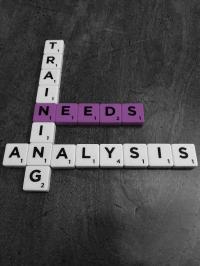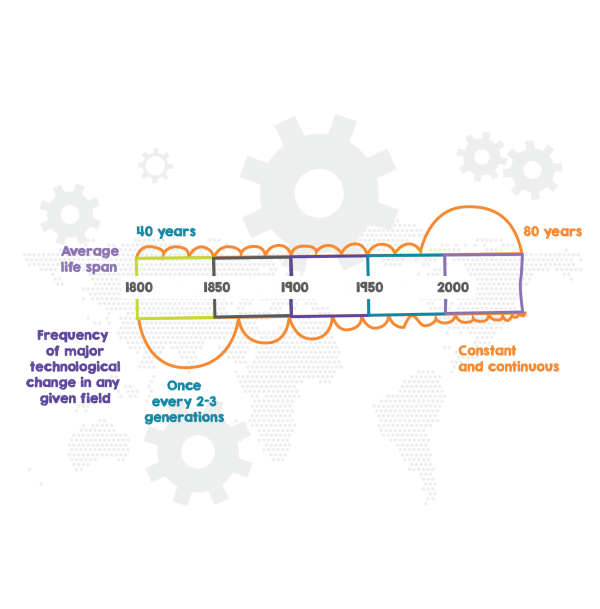Tools to make you THINK differently about your business
Why is training, and even lifelong learning, important?
Well, what our grandfathers learnt was pretty much the same as what their grandfathers learnt. Life was slow, the pace of change was slow, technology didn’t change. Like it or not (many of us don’t) but life ain’t like that now. As can be seen from the diagram above. The stuff a kid might learn at school can be out of date by the time they leave!
So if you want to drive your business forward, and the world is forever changing, a training needs analysis (TNA) can be one of the most important instruments you can apply to keep your company ahead of the competitive pack.
So, what are the benefits?
Undertaken properly, a TNA can:
• Focus your attention on the skills and know-how your people need for them to survive and you to thrive
• Provide an edge your company needs to stay ahead of the competition
• Entice top talent to join (and certainly stay) once they have joined
• Managed properly, it can even contribute to changing your culture, should you want it to
Given the pace of change, it’s hard to overstate the importance of training in today’s workplace. This means that TNA is critically important. It should underpin your plan for ongoing success.
What is a Training Needs Analysis?
Essentially a TNA is a process which helps you understand the current state of your organisation’s training and development activities and the knowledge/skills gaps your organisation needs to fill.
Many companies, especially construction companies, have elaborate spreadsheets and databases for ensuring that their people remain up to date with regulatory driven training; manual handling, asbestos, CSCS etc. TNA is about taking those ideas, supercharging them, and applying them to the training that is most likely to drive performance. TNA takes us from conformance to performance.
Once you have undertaken the analysis and you know what’s missing, you can outline your priorities and shape your training plans and your learning and development strategies.
At this point the NLP’ers ((Neuro Linguistic Programmers)…despite the name, a great subject for studying people) amongst us would have us use something called the Disney Strategy…Walt Disney, yes him of the Micky Mouse fame, created a three part strategy for thinking; the dreamer, the realist and the critic…he even created different rooms with distinctly different environments, for undertaking the different roles… we are now going to draw on a bit of that …
Step 1: Dream and imagine the future

We would say the only place to start with any TNA is with your organisation’s purpose, vision, mission and values. These statements taken together represent your North Star, your guiding light, the things you are aiming at in the long-term.
Review these documents, grab a coffee, sit back, take a deep breath and close your eyes… you are now the Dreamer, imagine what your organisation would look, feel and sound like if all of your people were delivering on every aspect of your North Star aspirations. Ask yourself:
• What would your company culture be like if your values were being lived all day, every day…by everyone?
• Which teams and people are key to delivering on your organisation’s North Star?
• What behaviours do your people need to deliver?
The organisation now in your imagination is the one you need to bring to life. Your training needs analysis is your vehicle for doing so.
Step 2: Research and assess
Coming out of Dreamer mode we are now in Realist mode.
The first step has been to bring your ultimate goal into focus, you now know what knowledge, skills and attitudes you need in your company. It’s now time for you to work out where you are and this usually calls for some research.
There are a lot of different tools and techniques for this ranging in complexity:
• For a small company it could be a simple face to face meeting with each of the staff
• For a larger complex, multi-sited, organisations it could be a bespoke software application or the hiring of consultants (like us! He said optimistically and excitedly!)
• Or it could be anything in between
The most common approach is to employ some kind of survey or questionnaire on which there is a long list of capabilities. Your staff would then self-report on these capabilities. (See the downloadable templates below).
However, in order to prevent a dictatorial “top down, done to” approach, we’d suggest that there is some allowance made for staff to contribute their own ideas about the skills, talents and interests they need to do their jobs. With this tiny adaptation you’ll get both better buy in and there is also a danger that you might also learn something!
A bit like the endorsement component of LinkedIn, in the more sophisticated environments, it is also possible for other staff members to endorse their colleague’s skills as a sort of “talent testimonial”.
Once the full range of knowledge, skills and attitudes has been obtained (no small task usually), you’ll have a full report of your organisation’s talents that can be plotted according to teams or departments. It should now be possible to identify skills, knowledge and attitudes lacking and where in the organisation they’re most needed.
You can then sort through all the skills gaps you’ve identified and rank them according to importance.
However, the key and the tricky part, is often behaviour change, which will mean you need to understand what knowledge and support your staff require.
As a short aside, there’s a great guy called B J Fogg who is the founder of the Stanford Persuasive Technology Lab, he’s the clever bloke partly responsible for teaching a number of key people in a number of hi-tech companies about “Tiny Habits” that lead to behaviour change and make some of our day-to-day tech’ “addictive”. His Tiny Habits behaviour model explains that to affect behaviour change, you need three things: motivation, ability and a trigger… The claim is, that with proper application with these three simple things, you can inspire your people to achieve anything!
Step 3: Develop the plan
At this stage, as the title hints, we are still in the Disney Realist mode and with all the detailed information you’ve gathered from your research, you have all the data you need to craft your training and development plan.
The company purpose, mission visions and values should provide a guide to your priorities to the knowledge, skills and attitudes that are lacking but critical to success.
After addressing these core gaps, you can work your way through other priorities until either you run out of budget or you run out of gaps. (My guess is it’ll be running out of budget first!)
You then need to decide how you want to deliver your training and how you will reinforce it so that your training leads to long-lasting behaviour change.
You’ll now be in a strong position to start establishing the ROI expected. You are also in a position to begin to set metrics to measure the success and impact of the planned training and development. (Watch out for further details on training evaluation in a blog to be released shortly)

However, before we leave the planning activities, we also need to switch into Disney’s Critic mode. We need to take a step back and stress test the plan. The questions to ask of ourselves, and for feedback from other interested parties, are:
• What do we think will go well?
• What do we think will not go so well?
• What are the consequences?
• What is the contingency?
Adjustments can then be made before execution, implementation and evaluation.
Step 4 Execute, implement and evaluate
The toil of planning is over, the plan is ready and its roll out time.
The plan would then be delivered in accordance with the activities timescales and milestones set.
The $64m dollar question is – Did it work?
The detail of this answer will be discussed in a future blog which will focus on training evaluation …but I’ll give you a clue …training can and should be evaluated on a number of levels:
• At the individual level
• At the departmental or team level and
• At the organisational level
The key question is; Did you get a “payback”? …which we’ll explore in the upcoming blog.
However, it is very unlikely the roll out won’t require some finessing along the way. Indeed, it is advisable that specific review points are actually planned to allow for deliberate adjustment. These might be scheduled for the first month and then every 3 or 6 months thereafter in order for you to take stock, learn and adjust the plan. Additionally, as part of this review process you should be looking to identify any hidden champions amongst your staff; those that have gained the most from the training and are applying it enthusiastically. These champions are beacons that can be employed as ambassadors, lightening your load and helping others who might be struggling.

Conclusion
TNA is a cool tool for systematically looking at the training required for your company and instead of “just doing some training” with no focus or aim, aligning training to the specific needs of the business.
In short, TNA is a great way to ensure:
• Your training is concentrated on what the business needs to drive future performance
• You get payback from the money, time and effort invested
• You systematically review the training required to get best bang for your buck
Related tools and ideas
- Investors in People
- BJ Fogg and behaviour change
Recommended references
- Investors in People
- Training evaluation (blog to follow)
- Motivation profiles
Downloadable resources
To find out how Statius can help you deliver:
• Better strategies
• Better systems
• Better measurement and
• Engaged people delivering
• Better results
Call us now on 0208 460 3345 or email sales@statius.co.uk



Comments are closed